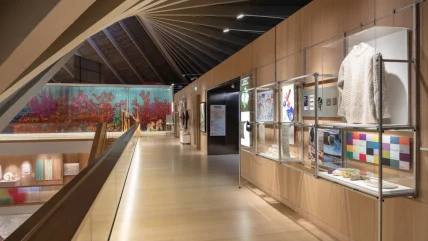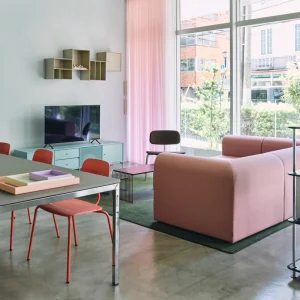
The Design Museum in London is hosting Tools for Transition, an exhibition focused on design research related to the green transition.
The display features projects from four UK universities in collaboration with designers, local authorities and communities, aimed at promoting sustainable living and community impact.
The exhibition includes four Green Transition Ecosystem research projects funded by Future Observatory – the Design Museum’s national research programme for the green transition – and the Arts and Humanities Research Council (AHRC) over the past two years.
The first project, Design Hopes, is based in Scotland. NHS Scotland declared a climate emergency in 2019 and aims to reduce carbon emissions by 2040. Design Hopes is investigating ways for NHS Scotland to lower its carbon footprint by mapping material flows in hospitals and identifying alternatives to plastic. Items on display include reusable theatre scrubs and caps made from plant-based materials such as flax and cellulose fibres.
The second project, Future Island-Island, focuses on Rathlin Island, Northern Ireland’s only inhabited offshore island, which aims to achieve carbon neutrality by 2030. This initiative involves community members, academics, and practitioners in developing sustainable resource management practices. Activities include repair cafés and community-led waste initiatives, with research into converting waste materials like sheep’s wool and marine plastic into useful items for the island.
Transforming Homes is the third project, which seeks to reform the construction industry by developing environmentally conscious building codes and materials. This project collaborates with local residents and authorities to improve older homes for modern living. Research includes monitoring heat loss and humidity to enhance performance, with the goal of influencing housing policy and design across the sector.
The final project, Public Map Platform, is an online tool designed to assist local authorities and communities in understanding local climate change issues for informed decision-making.
Abbie Adams, Future Observatory curator, stated: ‘The research on display in Tools for Transition is all work in progress, and it’s always interesting and challenging for a museum to show work that’s still evolving. I think we’ve captured these projects at a fascinating point of development, where there are prototypes and evidence of community engagement. And now it’s time to bring the public into the conversation.’
Tim Marlow, director of the Design Museum, added: ‘Future Observatory is unlike any initiative in any museum in the world. Its work is transformative, and the Design Museum is both energised and inspired to showcase this ongoing design research. This new display – Tools for Transition – demonstrates the impact design can have on local communities, individuals and indeed the environment in a variety of ways. The work is potentially both immediate and long-term and offers new ways of thinking about perennial problems.’
Tools for Transition will be on display at the Design Museum until autumn 2026. The exhibition is free to visit and has been curated by Adams, with support from the AHRC.





